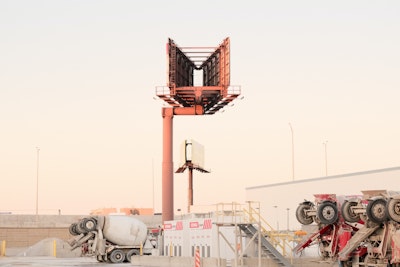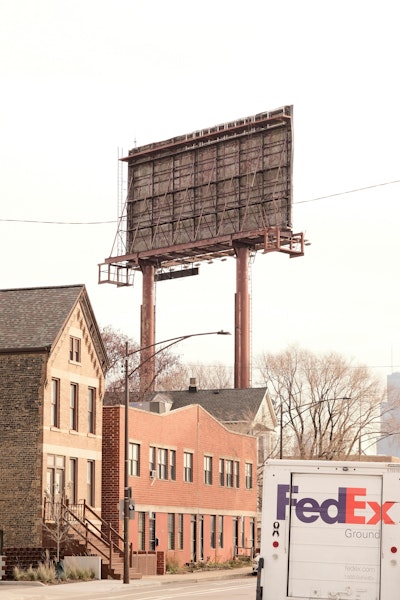Iron Portals of Chicagoland
Sentinels
Garofalo Fellow 2023-2024 at University of Illinois in Chicago
Location: Chicago, USA
Year: 2023-2024
Type: Research, Photography, Sculpture
Status: Ongoing
Photography: All images by Cédric Van Parys
Sentinels: Iron Portals of Chicagoland
Sentinels: Iron Portals of Chicagoland
“Transforming the meaning of the billboard as a representative monument of American culture by juxtaposing and reconciling word, image and object.”
As the 2023-2024 Garofalo Fellow at the University of Illinois, Chicago, I was quickly drawn to the billboard as a standardized, monumental, dignified, yet relatively unobstructed infrastructure. Through its massive size, a particular cantilevered design, and inviting advertisement slogans, the billboard acquires the properties of a monument—resembling guards or sentinels protecting and welcoming you to a certain area or community. An investigation was called for.
This Fellowship concluded with an exhibition at the University of Illinois, School of Architecture and the Arts, where I presented a series of photographic and sculptural artworks manifesting a conceptual and material appropriation. This was followed by a lecture at the Graham Foundation for Advanced Studies in the Fine Arts, Chicago.
Exhibition info
Exhibition Opening: Friday April 5, 2024, 6pm
Location: 845 W Harrison St, Chicago, IL 60607 School of Architecture at University of Illinois, Chicago.
Exhibition runs from Friday April 5, until Friday May 3, 2024
Lecture info
Lecture: Thursday April 18, 2024, 6pm
Location: Graham Foundation. 4 West Burton Place, Chicago, Illinois, 60610
Billboard Infrastructure
Billboard Infrastructure
The Billboard’s size and style of presentation, as we have known it throughout most of the past century, had its prototype in the Egyptian upright slabs of stone termed stelae by the Greeks, announcing decrees, warnings, and laws in public places. The Billboard’s imposing scale fits the American landscape and conveys its advertising message directly, without the distractions intrinsic to newspapers, magazines, TV, and internet. It was intended to do only one thing—sell. But the actual billboard (infra)structure— which has its origin in Chicago and is now, in 2023, counting up to 450,000 freestanding structures across the country—became the monument of an urbanized, modern, capitalist, and technological society. It acquired central symbolic importance for the New World and shaped the identity of the United States as an individualist consumer culture on the move.
Monuments
Monuments
There are plenty of surveys of the American landscape littered with commerce and ads, but I have no interest in advertisement itself or consumer research. I’m interested in the effect of these steel monopole structures on the people and the (local) urban environments. The billboard’s monetized side faces the highway and is directed mainly to drivers and passengers. But from every other viewpoint, we see a massive structure that removes part of the sky. Documenting and photographing those hyper-functional backsides reveals a monumental sacredness that is not so different from Native American Totem Poles, Nigerian Shango staffs, or Inuit Inukshuk stone landmarks. They are all markers of space.
While traveling Chicagoland, mapping and photographing as many billboards as possible, I also browsed the online inventories of major advertisement companies (such as Lamar, Outfront, and Clearchannel), listing the advertisement strengths and technical data of each photographed structure. By describing the advantages of advertising on a particular billboard, such as long traffic jams, affluence, demographics, restaurants, and nightlife, these vendors provide a blunt but detailed description of the neighborhood and community surrounding that billboard. This detailed information helps businesses define their ads and slogans to target the right audience. Juxtaposing the images of the physical structures with its advertisement strengths and slogan generates a surreal effect that transforms the meaning of the billboard as a representative monument of American culture.
Context
Context
The billboard influences their proximate and urban contexts, just as these contexts significantly influence their design and form. To understand its full cultural and monumental significance, it is crucial to change perspective from functional pragmatism to spiritual fundamentalism, which triggers real familiarity and a sense of security. Such familiarity is often evoked through classic elements of architecture that have belonged to the universal formal lexis for ages. Columns, pillars, portals, stairs, and vaults are the basis for all historic buildings because they reveal similarities that bridge continents. Interestingly, the most characteristic structural element of the billboard is the joint plate, where the column meets the torsion bar. Its sophisticated design—to resist wind loads— is unique to the monopole cantilevered billboard structure. Still, its aesthetic and spatial quality are also reminiscent of ancient Greek or Roman portals or gates consisting of columns, capitals, and architraves.
Sculpture
Sculpture
If the photography shows the dominance of the billboard infrastructure in space, then the sculptural work aims to cement its value as an essential monument of American cultural heritage. As an artistic exploration, it feels logical to appropriate and transform the billboards into a series of open-form classical sculptures that visitors can walk around and (potentially) enter. Transforming, scaling, modifying, and reconstructing these (infra)structures into portals—with advertisement slogans as inscriptions— re-enforces the perception of the billboards as Sentinels. Not unlike the caryatids protecting a shrine, they guard and protect while at the same time welcoming you home.
Lecture: Graham Foundation for Advanced Studies in the Fine Arts
Lecture: Graham Foundation for Advanced Studies in the Fine Arts
This lecture follows the opening of the exhibition “Sentinels” at the University of Illinois, School of Architecture and the Arts in Chicago. As the 2023-2024 Garofalo Fellow, Cédric Van Parys has transformed the meaning of the billboard as a representative monument of American culture by juxtaposing and reconciling word, image and object. This lecture at the Graham Foundation elaborates on his creative process, from initial research to conceptual and material appropriation.
Lecture: Thursday April 18, 2024, 6pm
Location: Graham Foundation. 4 West Burton Place, Chicago, Illinois, 60610
Gallery



























